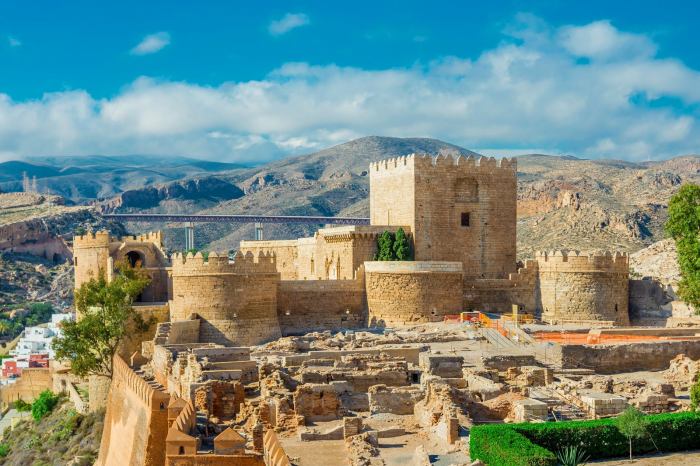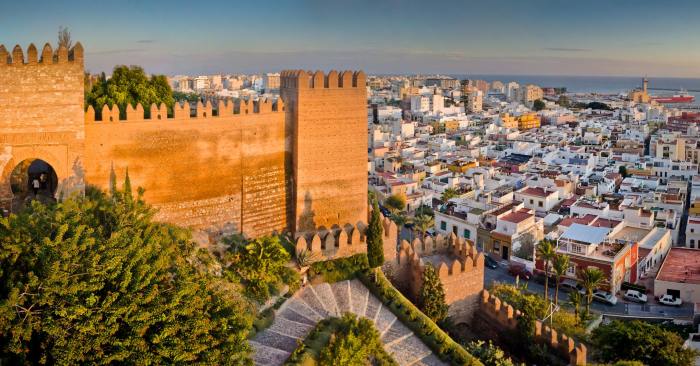Nestled along the sun-kissed shores of southeastern Spain, Almeria emerges as a vibrant tapestry woven with rich history, captivating traditions, and breathtaking landscapes. From its ancient origins to its modern-day allure, Almeria beckons travelers and historians alike to embark on a journey through time and culture.
Throughout the centuries, Almeria has borne witness to the rise and fall of civilizations, leaving behind a legacy of architectural marvels and cultural traditions that continue to enchant visitors today. Its strategic location on the Mediterranean Sea has shaped its destiny, serving as a crossroads for trade, conquest, and cultural exchange.
History of Almeria
Almeria’s history dates back to ancient times, with evidence of human habitation from the Neolithic period. The city was founded by the Phoenicians in the 6th century BC and was known as Portus Magnus.
Almeria, with its rich history and stunning natural beauty, offers a captivating experience. Its captivating landscapes invite exploration, while its vibrant culture adds a lively touch to your journey. If you seek a contrasting adventure, venture to Albany , where historic charm blends with modern attractions.
Upon your return to Almeria, you’ll find that its allure remains, inviting you to delve deeper into its captivating tapestry of culture and nature.
The Romans conquered Almeria in the 2nd century BC and renamed it Portus Almeriae. The city became an important trading center and a base for the Roman fleet. After the fall of the Roman Empire, Almeria was ruled by the Visigoths and then by the Moors.
Moorish Period
The Moors ruled Almeria from the 8th to the 15th century. During this time, the city flourished as a center of trade and culture. The Moors built the Alcazaba, a fortress that is still one of the city’s most iconic landmarks.
Christian Reconquest
The Christian reconquest of Almeria began in the 13th century. The city was finally conquered by the Spanish in 1489. After the reconquest, Almeria became a major port city and a center of the Spanish Inquisition.
Modern History
In the 19th century, Almeria became a center of the mining industry. The city’s population grew rapidly during this time. In the 20th century, Almeria became a major tourist destination. The city is now known for its beautiful beaches, its historic architecture, and its vibrant culture.
Almeria, a captivating coastal city in southeastern Spain, is a treasure trove of historical landmarks, stunning beaches, and delectable cuisine. If you’re planning your 2024 travel itinerary, be sure to include Almeria on your list of best travel destinations.
From exploring the majestic Alcazaba fortress to basking in the sun at Playa de los Muertos, Almeria offers an unforgettable experience.
Geography and Climate

Almeria is located in southeastern Spain, on the Mediterranean coast. It is bordered by the provinces of Granada to the west, Murcia to the north, and the Mediterranean Sea to the east and south. The province has a total area of 8,774 square kilometers (3,388 square miles).
The topography of Almeria is varied, with mountains, hills, valleys, and plains. The Sierra Nevada mountains run along the northern border of the province, and the Cabo de Gata-Níjar Natural Park is located in the southeast. The province is also home to several rivers, including the Guadalquivir, the Almanzora, and the Andarax.
Climate
Almeria has a Mediterranean climate, with hot, dry summers and mild, wet winters. The average temperature in January is 10.5°C (50.9°F), and the average temperature in July is 27.5°C (81.5°F). The average annual rainfall is 250 millimeters (9.8 inches).
| Month | Average Temperature (°C) | Average Rainfall (mm) |
|---|---|---|
| January | 10.5 | 25 |
| February | 12.0 | 20 |
| March | 14.5 | 25 |
| April | 17.0 | 30 |
| May | 20.5 | 35 |
| June | 24.0 | 40 |
| July | 27.5 | 45 |
| August | 28.0 | 50 |
| September | 25.5 | 45 |
| October | 22.0 | 40 |
| November | 17.5 | 35 |
| December | 13.0 | 30 |
Culture and Traditions
Almeria’s culture is a vibrant tapestry woven from diverse influences, reflecting its rich history and unique geographic location. The city’s traditions and customs have been shaped by centuries of Moorish, Christian, and Spanish heritage, creating a blend that is both distinct and captivating.
Local Cuisine
Almeria’s cuisine is renowned for its freshness and simplicity, showcasing the region’s bountiful harvests from the sea and land. Freshly caught seafood, such as red mullet, sea bass, and squid, are grilled or fried to perfection, while local vegetables like tomatoes, peppers, and onions form the base of many traditional dishes. The province is also famous for its olives and almonds, used in a variety of culinary creations.
Economic Activities

Almeria’s economy is primarily driven by agriculture, tourism, and manufacturing. Agriculture plays a significant role, with greenhouses covering vast areas, producing fruits and vegetables for export and local consumption. Tourism has been growing rapidly, with the city attracting visitors to its historic sites, beaches, and natural landscapes. Manufacturing includes sectors like textiles, plastics, and pharmaceuticals. The city has experienced steady economic growth in recent years, with a focus on sustainability and innovation.
Agriculture
Almeria is renowned for its agricultural industry, particularly its innovative greenhouse technology. The province produces a wide variety of fruits and vegetables, including tomatoes, cucumbers, peppers, and melons. These crops are exported throughout Europe and beyond, contributing significantly to the local economy.
Tourism, Almeria
Tourism is a major growth industry in Almeria. The city boasts a rich historical heritage, with landmarks like the Alcazaba fortress and the Almería Cathedral. Its stunning beaches, such as Las Salinas and Cabo de Gata, attract tourists from around the world.
Manufacturing
Almeria’s manufacturing sector includes a diverse range of industries. The textile industry has a long history in the city, producing high-quality fabrics and garments. Other important sectors include plastics, pharmaceuticals, and renewable energy equipment.
Notable Landmarks and Attractions
Almeria boasts a rich tapestry of historical, cultural, and natural landmarks that captivate visitors from around the world. From ancient fortresses and Moorish palaces to pristine beaches and rugged mountains, the city offers an eclectic mix of attractions that cater to diverse interests.
To fully immerse yourself in the city’s vibrant heritage, embark on a guided tour that unveils the secrets and stories behind its most iconic landmarks. Here’s an itinerary that highlights some of the must-visit attractions in Almeria:
Alcazaba of Almeria
This magnificent fortress, perched atop a hill overlooking the city, is a testament to Almeria’s rich Islamic past. Built in the 10th century by the Caliph of Cordoba, the Alcazaba served as a strategic military stronghold and a symbol of Moorish power. Explore its labyrinthine walls, towers, and courtyards, and marvel at the intricate architecture and stunning views.
Cathedral of Almeria
Located in the heart of the city, the Cathedral of Almeria is a masterpiece of Renaissance architecture. Begun in the 16th century, the cathedral boasts an impressive facade adorned with intricate carvings and sculptures. Step inside to admire its soaring vaults, elegant stained-glass windows, and exquisite artwork, which narrate the history and faith of the region.
Cabo de Gata-Níjar Natural Park
Just a short drive from the city, Cabo de Gata-Níjar Natural Park is a breathtaking natural sanctuary. Spanning over 30,000 hectares, the park encompasses pristine beaches, rugged cliffs, volcanic landscapes, and abundant wildlife. Embark on a hike through its scenic trails, go snorkeling or diving in its crystal-clear waters, or simply relax and soak up the beauty of this unspoiled paradise.
Alcazaba of Guadix
Although located about an hour’s drive from Almeria, the Alcazaba of Guadix is a worthwhile addition to your itinerary. This impressive fortress, built in the 11th century, is a testament to the region’s Moorish heritage. Explore its well-preserved towers, ramparts, and courtyards, and immerse yourself in the history and culture of this ancient stronghold.
Museo de Almeria
For a deeper understanding of Almeria’s history and culture, visit the Museo de Almeria. Housed in a beautiful 19th-century building, the museum showcases a diverse collection of artifacts, from prehistoric tools and Roman mosaics to medieval ceramics and modern art. Wander through its galleries and discover the rich tapestry of Almeria’s past, from its humble beginnings to its present-day vibrancy.
Transportation and Accessibility: Almeria

Almeria boasts a well-developed transportation infrastructure that caters to various modes of travel. The province is accessible by air, rail, and road, with efficient public transportation options to facilitate convenient movement within the region.
Airports
Almeria Airport (LEI) is the primary airport serving the province. It offers regular flights to major domestic and international destinations, connecting Almeria to cities like Madrid, Barcelona, London, and Paris.
Almeria’s stunning beaches are a must-visit for any beach enthusiast. But if you’re looking to explore beyond the shores of Spain, check out our guide to the best beaches in the Caribbean. From the turquoise waters of Jamaica to the white sands of Barbados, the Caribbean offers a diverse range of beach experiences that will leave you breathless.
And when you’re ready to return to the Mediterranean, Almeria’s beaches will be waiting with open arms.
Railways
Almeria is connected to the national railway network via the Linares-Baeza railway line. The Almeria railway station provides intercity and regional train services, linking the province to major cities in Andalusia and beyond.
Roads
Almeria is well-connected by a network of highways and national roads. The A-7 motorway (Autovía del Mediterráneo) runs along the Mediterranean coast, providing a direct route to Malaga and Murcia. Other major roads include the A-92 (Autovía de Andalucía) and the A-334 (Autovía de Sierra Nevada), connecting Almeria to Granada and the interior of the province.
Public Transportation
Almeria has a comprehensive public transportation system that includes buses, trams, and taxis. The city bus network covers all major neighborhoods and tourist attractions, while the tram system provides a convenient and efficient way to travel between the city center and the beach area. Taxis are readily available throughout the province, offering a reliable and comfortable mode of transportation.
Last Point

As we conclude our exploration of Almeria, we are left with a profound appreciation for its enduring spirit and timeless beauty. From the grandeur of its historical monuments to the warmth of its people, Almeria stands as a testament to the enduring power of human creativity and the indomitable spirit of a region that has embraced its past while confidently striding towards the future.
Frequently Asked Questions
What is Almeria famous for?
Almeria is renowned for its stunning natural beauty, rich history, and cultural heritage. It is home to the only desert in mainland Europe, the Tabernas Desert, and boasts a coastline dotted with picturesque beaches and coves.
What are the must-visit attractions in Almeria?
Almeria offers a wealth of attractions, including the Alcazaba, a magnificent Moorish fortress; the Cathedral of Almeria, a Gothic masterpiece; and the Tabernas Desert, a unique and captivating natural landscape.
What is the best time to visit Almeria?
The best time to visit Almeria is during the spring or fall, when the weather is mild and pleasant. However, Almeria is a year-round destination, with warm winters and hot summers.